Put our experienced, fully licensed, OEM-trained electrical team to the test. Available 24/7.

Electric Motor Repair
This essential guide covers what you should know when sending your motor to the shop and why you should care about service and quality.
If you’re involved in plant operations or maintenance and know you have to repair an electric motor, then this guide is for you.
What you get: What to consider when selecting a motor repair shop, the fundamentals of the motor repair process, motor repair standards and specifications, the barriers to quality motor repair, and how to elevate and encourage quality motor repair.
Any motor will fail eventually; nothing lasts forever. It’s easy to blame age, but most motor failures occur earlier than necessary due to insufficient lubrication, electrical system problems, improper prior repair, and any conditions that lead to overheating or excessive moisture. Read more about electric motor failure in our comprehensive guide.
So what's next? If you're not sure what's wrong with the motor, and you think the issue is minor, then you can call a field service technician to come to your site and evaluate the motor. They can run a variety of tests and tell you whether the repair can be done onsite or if it needs to be sent to a repair shop.
Get a second opinion
Did you know? Lower horsepower motors are more likely to be replaced, while higher horsepower motors are more likely to be repaired (cost is a big factor).
Do Your Homework Before Selecting a Motor Repair Shop
This guide will focus on sending your motor to a repair shop. This scenario is more likely if the motor is susceptible to its environment, physical space requirements, lifting, and tooling.
When selecting a motor repair shop, customers usually consider a few essential criteria: fast turn-around time, reliability, and technically skilled staff.
Customers rarely provide specific criteria beyond returning the motor to its original condition. The lack of specification is usually because the customers don’t have the background knowledge to identify quality motor repair work.
Getting your motor back ASAP is one thing, but has the job been completed with precision and care?
Customers need the tools and knowledge to recognize quality motor repair and understand things like:
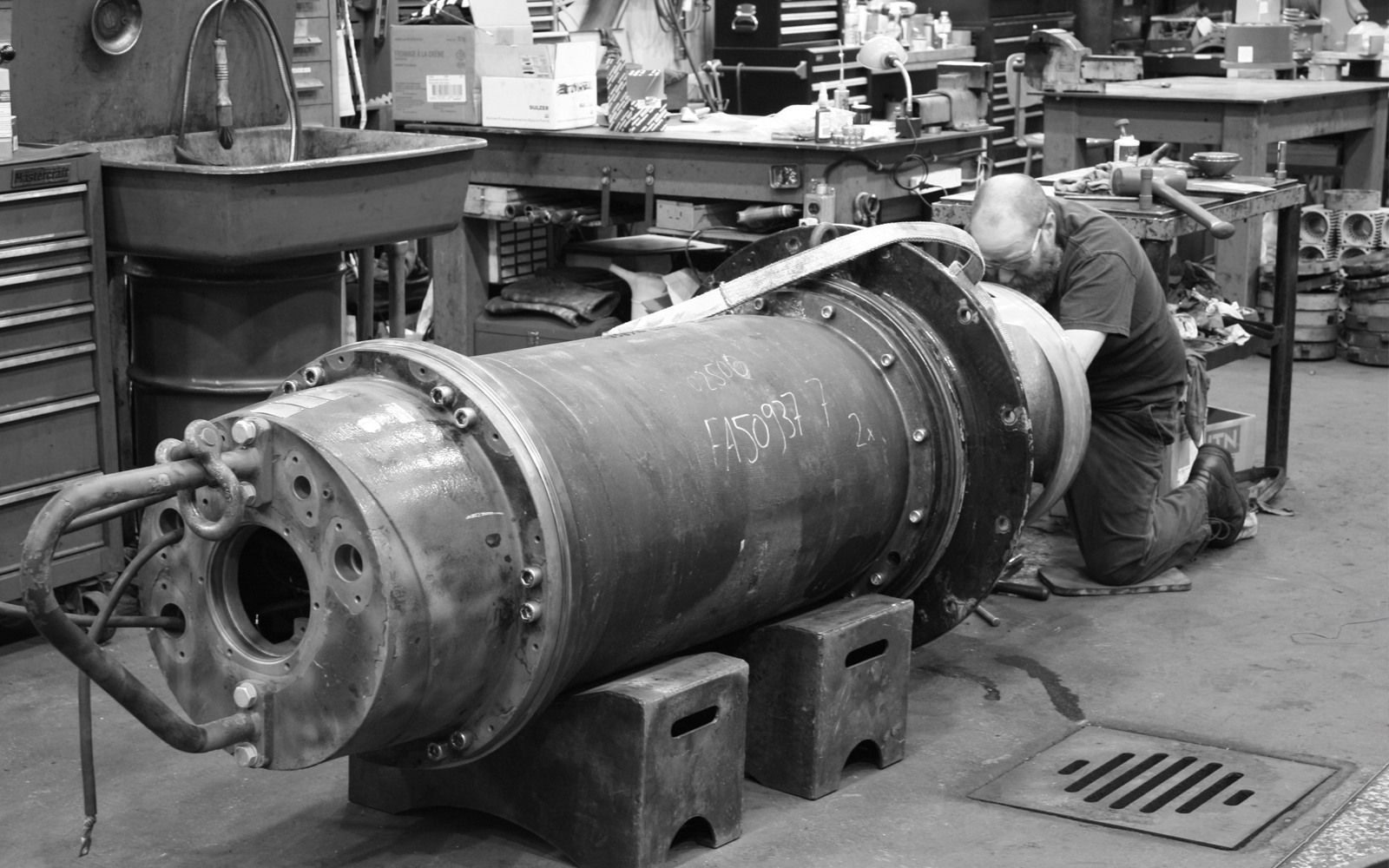
Did you know? 90 to 95 percent of bearing failures in electric motors are caused by excessive external loads created by the customer and their application or maintenance practices.
Key Questions to Ask a Motor Repair Shop
To ensure a quality motor repair job, it’s essential to have a specification outlining the scope and quality of work. And to select a skilled and reputable service centre. To choose a top-notch repair shop, you should obtain some critical information in your investigation. Not sure if your current repair shop is up to snuff? Read here for 6 signs it’s time to go shopping.
Here are some key questions to ask your candidates. If they don’t measure up, then keep looking.
Did you know? Motor repair shops should NOT make mechanical modifications without your prior approval.
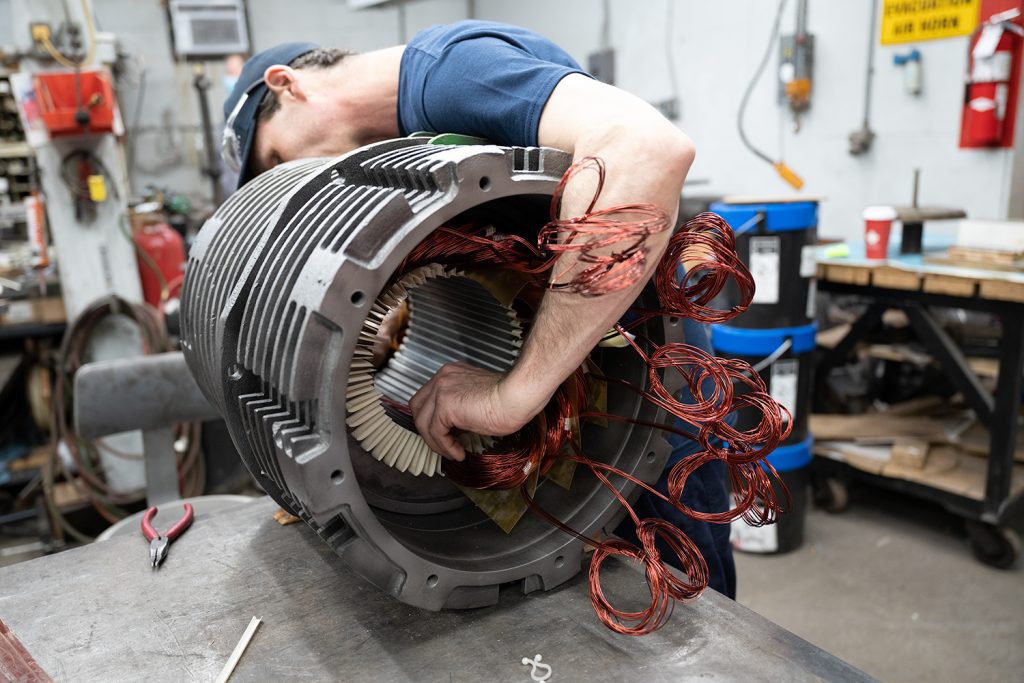
A checklist is beneficial to take with you when interviewing motor repair service centres. You should reserve at least half a day to conduct a comprehensive evaluation of the service centre. Give the general manager a heads up on any documents you need and try not to treat the evaluation as an interrogation. You want to work together at the end of the day, so try to promote a positive working relationship from the start. If you’d like, you can provide the checklist to the service centre manager ahead of time, so any hard-hitting questions don’t blindside them.
That motor giving you headaches? Let us have a look.
The Motor Repair Process
Motor repair customers should have a basic understanding of the repair process. The motor repair will vary based on the extent of damage, but there are typical motor repair processes you should be aware of. By no means is the below information the whole picture.
If you’re sending a motor to a repair shop or using a third party, read this piece to ensure it’s done right.
Inspection
The motor is received and logged, and a form is filled out to outline the motor’s condition and the expected repairs. A form of record keeping is prepared to document findings and actions taken to repair.
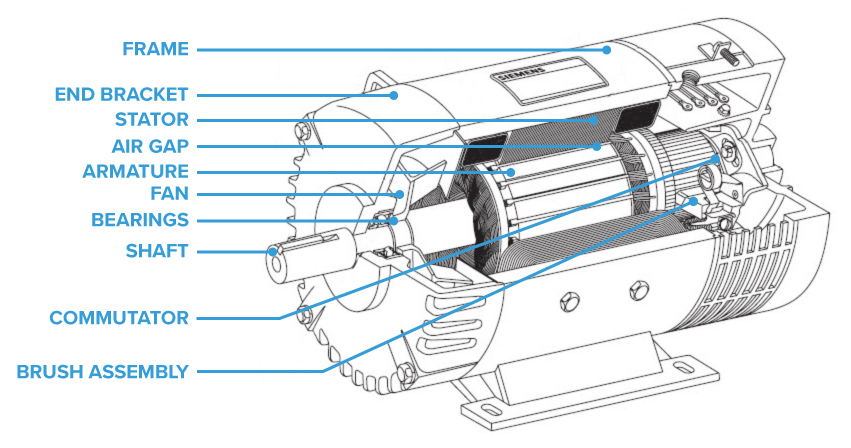
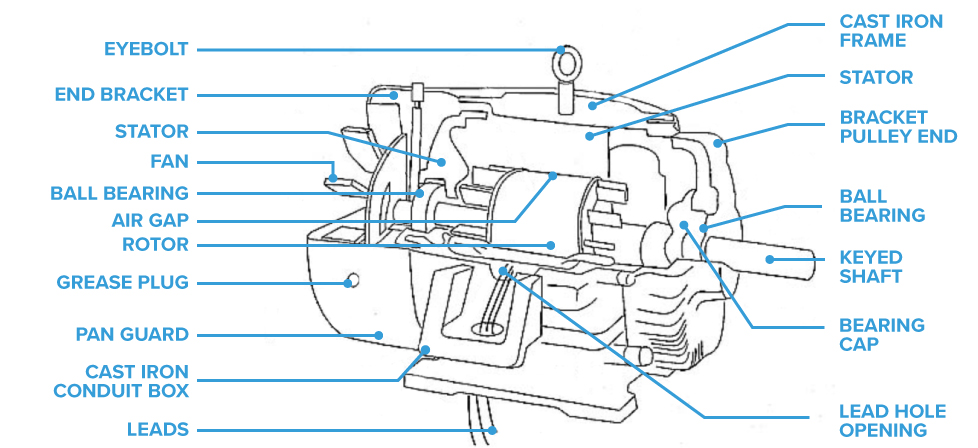
The initial inspection will determine the likely cause of the problem and what work is required. If the winding doesn’t appear damaged, it will be tested for insulation integrity. Then the shaft is rotated to check for any bearing problems.
If the motor is still operating, it will be run at full voltage with no load on the shaft to check for balanced current and vibration. Winding resistance is then measured, and results are documented.
Dismantling
When the motor is dismantled, the current conditions are documented. For instance, the bearings will be checked for electrical insulation methods, and the configuration of thrust bearings will be recorded. After dismantling, core-loss testing is performed using a commercial tester or a loop test, as documented in the next bullet.
Core Preparation
A core flux test is performed before burnout oven processing the stator and before winding. Any defects identified need to be addressed before winding, like checking the tightness of the core, checking the integrity of ventilation support fingers, and straightening any bent or displaced lamination teeth.
Core integrity checking includes looking for the following:
- Weld cracks in the frame or between the frame and core
- Core waviness
- Core joint lamination displacement or buckling
- Vent finger movement
- Core bolt insulation measurement
- Localized core heating
- Wedge groove damage
- Greasing evidence of core movement in the stator frame
Any hot spots need to be taken care of by grinding, etching, insulation insertion, or lamination grinding and re-insulation. If core losses are too high, the core should be completely overhauled or replaced.
The coils are ordered (correct coil fitting is critical!), and the core is prepped for winding (cleaned and painted). Then the motor techs ensure the winding materials have been ordered with delivery planned to meet the customer's deadline.
Windings
What's involved when inspecting the motor windings?
To diagnose the cause of a winding failure, five key areas should be analyzed:
- Failure mode: regardless of cause, the mode of failure can further be broken down into turn to turn, coil to coil, phase to phase, coil to ground, and open circuit.
- Failure pattern: can further be classified into symmetrical, single phasing, non-symmetrical with grounding, and miscellaneous non-symmetrical without grounding.
- Appearance: the general appearance of the motor usually gives a clue as to the possible cause. Consider the following:
- Is the winding clean?
- What foreign materials are present?
- Any signs of moisture?
- Has there been rotor rub or pullover?
- Any signs of overheating?
- Are the topsticks, coils, or coil bracings loose?
- Are the bearings free to rotate?
- Any mechanical parts missing?
- Are the motor cooling passages free and clear of clogging debris?
- Application: consider the general operating conditions and ask questions like:
- What is the load characteristic of the driven equipment?
- Were there cycling or pulsating loads?
- Any chance of stallout?
- What was the voltage and was it balanced?
- Was the motor powered by a variable frequency drive?
- Any signs of transient voltage conditions?
- How long had the motor been running?
- What was the acceleration time?
- What was the condition of the motor controller?
- What kind of motor protection is in the system?
- What is the environment? Indoors or outdoors?
- What was the ambient temperature?
- Maintenance history: understanding the past performance of the motor can give a good idea of the cause of the problem. Consider:
- How long has the motor been in service? If it failed on startup, you can exclude things like contamination, transients, coil movement, and thermal aging.
- During the initial operation of the motor, were any unusual phenomena observed?
- Was the winding resistance and current balanced?
- Do past records indicate any cracking or aging of the insulation system?
To remove old windings, the varnish bond has to be removed by burning it using chemicals, mechanical force, or both. Burn-out is the most common method and involves cutting off one end of the motor with a special saw. The motor is placed in a burn-out oven and is heated to no more than 650 F to avoid overheating.
Burn-out ovens typically have temperature controls and a water injection system to prevent significant temperature rises. The process should be complete after several hours, at which point the stator is removed and cooled, and the old wire can be pulled out mechanically and recycled.
Rewindings
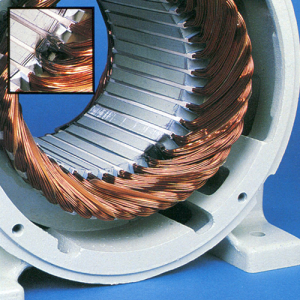 If the winding configuration appears damaged because of a previous repair, obtaining the records from the manufacturer, EASA, or the repair shop might be necessary. If the records aren’t available, the winding configuration must be redesigned, commonly referred to as "reverse engineering."
If the winding configuration appears damaged because of a previous repair, obtaining the records from the manufacturer, EASA, or the repair shop might be necessary. If the records aren’t available, the winding configuration must be redesigned, commonly referred to as "reverse engineering."
TIP: You should check with the motor shop whether they have the capability to complete the rewinding successfully from mechanical handling of the machine or stator to the capability to turn the stator to facilitate winding. For example, do they have a large enough controlled pyrolysis burnout oven? Do they have staff who are experienced in rewinding? Etc.
When rewinding, it's important that all newly manufactured coils are carefully inspected when received by the shop to assure quality and avoid costly warranty work.
The new windings are prepared on a special machine using magnet wire insulated with enamel. The wire is wound into layers, shaped, and then wrapped in tape to form a rigid coil with very little wasted space.
At this time, coils are inserted into the stators; insulating materials are used to line slots, secure end turns, replace temperature sensors, and attach lead wires. Then the motor is tested to verify proper winding and connection. To stabilize and insulate the windings, the entire stator is submerged in a varnish tank, removed, then baked to harden.
Rotor Repair and Testing
Usually, there are no severe problems with rotors, as they have no wires or moving parts. But things happen, including cracked squirrel cage bars, bent shafts, and out-of-balance conditions.
Rotors are repaired using different methods, as appropriate. And all rotors should be balanced, which involves spinning the rotor on a special fixture with vibration sensors at the bearing points. The vibration sensors tell the repair tech where to place balance weights.
Bearings
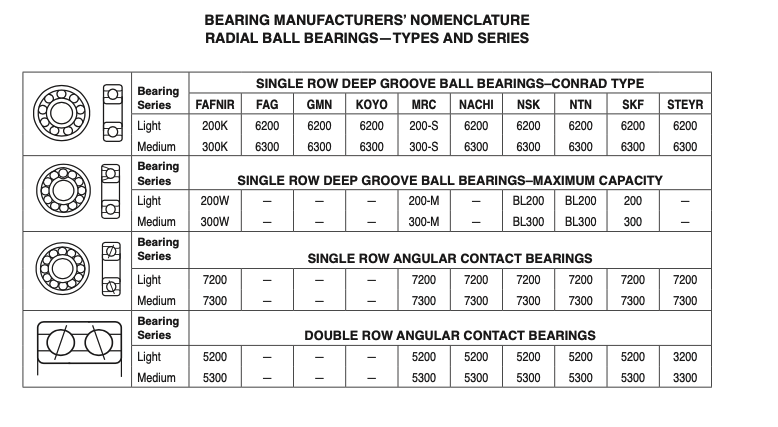
Ball and roller bearings are manufactured to very strict tolerance specifications and must be treated as precision parts, so they don't fail prematurely.
Your motor shop will perform a vibration frequency analysis to expose bearing defects. Defects in general rolling element bearings can be generated by wear, fatigue, poor installation, improper lubrication, and sometimes manufacturing faults in the bearing components.
The rolling element bearing comprises the outer race, inner race, cage, and rolling element (ball or roller), as shown below.
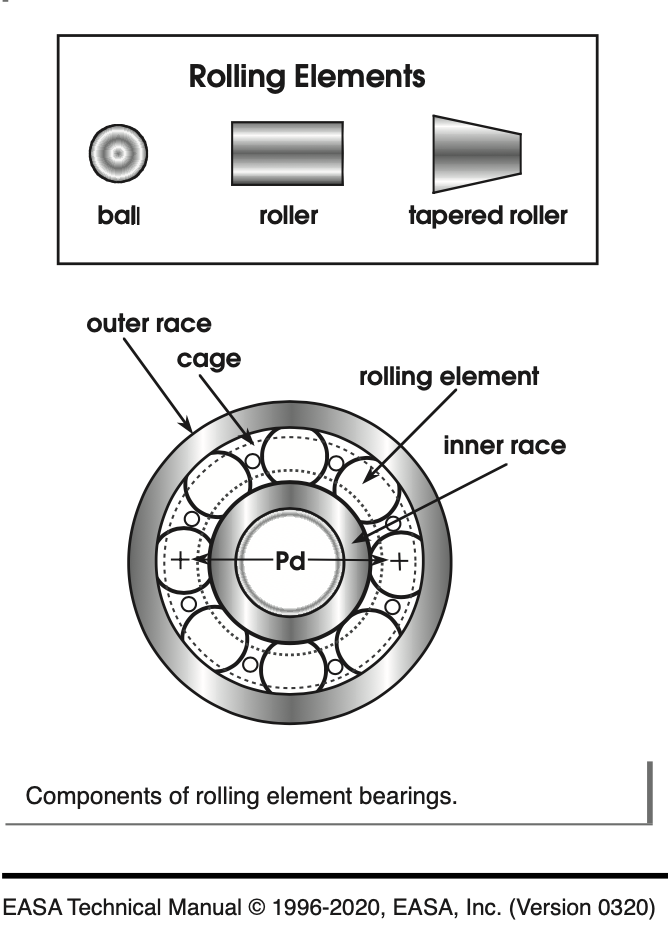
When a bearing spins, any irregularity in the raceway surfaces or roundness of the rolling elements causes periodic frequencies called fundamental defect frequencies. These defect frequencies depend on the bearing geometry and shaft speed. If any of these defects are detected, the motor tech will replace the bearing and ensure the housing fits and shaft journals are within tolerance.
On the other hand, sleeve bearings do not use rolling elements; rather, the shaft rides on a layer of lubricating oil inside the bearing bore. Sleeve bearings with excessive wear exhibit a vibration spectrum similar to the figure below.
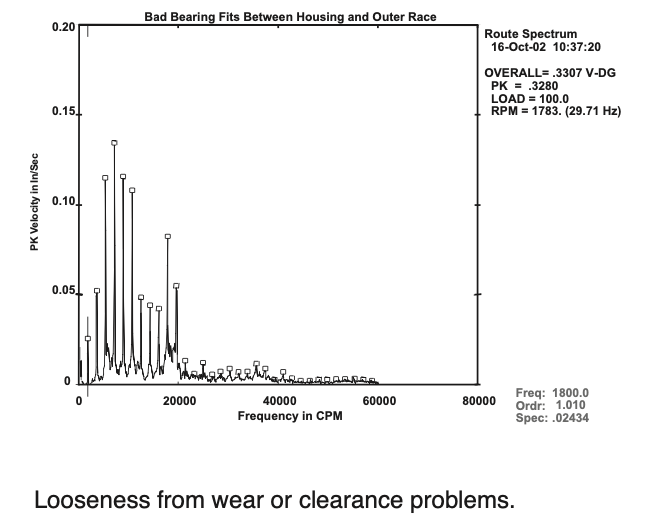
The final vibration test in the motor shop will let you know you're receiving a quality repair.
Read this to uncover detailed steps on bearing inspection. Or this piece covers why bearings fail and what to do about it.
Reassembly & Final Testing
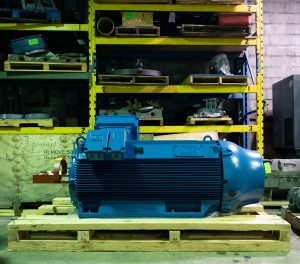 If the stator has been rewound, the insulation will be tested for resistance and a winding or surge comparison test is completed. The reassembled motor is then connected and run with no load to verify balanced current and vibration within standard limits. The motor is then painted and prepared for shipment.
If the stator has been rewound, the insulation will be tested for resistance and a winding or surge comparison test is completed. The reassembled motor is then connected and run with no load to verify balanced current and vibration within standard limits. The motor is then painted and prepared for shipment.
Ready to get some expert help? Request a repair today, we're here for ya!
Motor Repair Standards and Specifications
Improperly repairing and rewinding motors can decrease the efficiency of motors by up to 5 percent. This might not seem like a big deal, but when you factor in operating hours, the potential energy and dollar savings are substantial. Maintaining energy efficiency during repair should improve motor performance and reliability.
Typically, motor repair resulting in decreased efficiency is linked to:
- Shortcuts
- Errors
- Parts substitutions
So, motor repair shops must diagnose potential sources of decreased efficiency through testing before and after repair. And by following motor repair standards and specifications.
There are two standards in the motor repair industry: standards for motor repair and repair-related procedures and standards for motor efficiency testing. The motor efficiency testing standards outline detailed information on testing procedures, testing equipment, and calculations. And they inform shop-floor practice and policy.
On the other hand, motor repair standards cover a more comprehensive range and provide a solid framework of quality assurance standards in the repair industry. The downfall with motor repair standards is that they are either too broad and general or too detailed and complex to understand and transfer to the shop floor.
The EASA-Q Quality Management System was developed by EASA in 1993 and is based on currently applicable ISO standards. It covers all phases of motor repair shop operation, including management responsibilities, record keeping, equipment inventory and calibration, process control, safety and training, and performance measurement. EASA-Q certification indicates that a motor shop will provide quality motor repair services (but not guaranteed). If the motor repair shop indicates that it has another form of quality assurance standards and procedures, ask if the standard conforms to the latest ISO standards.
Barriers to Quality Motor Repair
Quality motor repair is a process that involves getting many small details right, including, but not limited to:
- Using the correct replacement bearings
- Proper greasing
- Avoiding mechanical modifications to bearings during disassembly or reassembly
- Avoiding overheating the core during removal of windings
- Protecting core laminations during the repair to stop shorts from happening
- Maintaining circular mils and the number of turns in the windings
- Maintaining winding patterns and their design
- Replacing loose/cracked conductor bars
- Detecting and repairing damage to end shields or bent motor shafts
- Maintaining air-gap symmetry between the rotor and stator
Quality motor repair is also hampered by broader forces like educational, infrastructural, and technical barriers.
Educational Barriers
As mentioned above, educational barriers exist because customers do not have the background knowledge and tools to recognize and specify a quality motor repair. Customers need to understand:
- The basics of a quality motor repair
- The challenges experienced by motor repair shops, including time and financial constraints
- The value of paying more for a quality motor repair job
- The importance of maintaining motor efficiency
So, what can motor repair shops do to encourage customers to learn more about quality motor repair? Fact sheets are a great starting point to educate customers on how to identify quality repair shops and the basics of good repair. Another idea is to access independent motor testing and assessments to help customers understand the repair vs. replace option. Duke is on the case with our motor failure decision tool.
Infrastructure Barriers
Motor specifications for bearings, fans, and lubricants are not accessible in a timely fashion from all motor manufacturers. These specifications are critical for returning the motor to its original condition. Sometimes, the motor can be reverse-engineered (which Duke can do), but the process is time-consuming.
Data availability is another problem. Motor manufacturers aren’t keen on providing data to make motors more repairable, and some consider it proprietary information. There’s no incentive for manufacturers to offer any data promptly.
Parts, wire sizes, tools, and equipment for winding and redesign are not readily available. The cost of maintaining extensive inventories of seldom-used parts doesn’t make financial sense. So some shops will make substitutions if the correct sizes aren’t accessible.
Technical Barriers
Many of the current winding removal strategies end up damaging motor cores. Since most windings are removed by burning them out in ovens, with temperatures of 750 F or more. Core damage is inevitable without temperature sensors in the motor cores and inadequate temperature controls.
A general lack of standardized designs also creates a barrier to quality motor repair. Finding parts and wires for motors using non-standard components is challenging and time-consuming. The European motor market has recognized this and is making more standardized motor designs headway.
Finally, more comprehensive data on the costs and effectiveness of motor repair remedies are needed. For example, how much do specific repair practices that maintain efficiency contribute to reliability and performance? Or what are the added costs for specific repair practices that support efficiency?
Ready to leave it to the pros? Drop us a line, we'll get you back up and running in no time.
How to Encourage
Quality Motor Repair
Market Transformation
Encouraging quality motor repair requires overall market transformation. To transform the motor repair market to fast-track the adoption of quality motor repair practices requires a national effort involving key players in the industry and government. For example, key sectors can collaborate with local repair shops to establish industry-led certification programs, which will help bolster quality repair and assurance efforts.
Another way to encourage quality repair and transform the market is through grants or financing from critical industries and the government. Financial assistance could help decrease the initial cost of ISO and EASA-Q certification and recertification. Manitoba Hydro, for instance, ran a great program where they offered to pay for half the price of a core-loss tester up to a maximum of $10,000 in exchange for the motor repair shops participating in developing a Quality Motor Service Program.
The manufacturers of motors also have a role to play in transforming the market to encourage quality motor repair. They should be encouraged to provide more robust and timely information on original motor design and test specifications to motor repair shops. It also wouldn’t hurt to improve the information they provide in nameplate data (read more about nameplate information). And finally, they could stock replacements for custom bearings without the crazy mark-ups.
If you're still up sh*t's creek with a weak or not functional motor and not sure what to do next, reach out to us.
